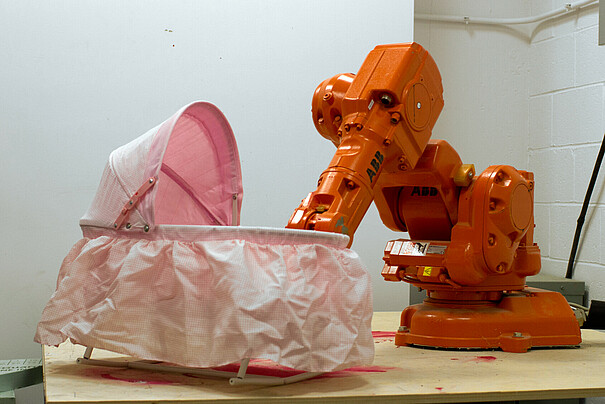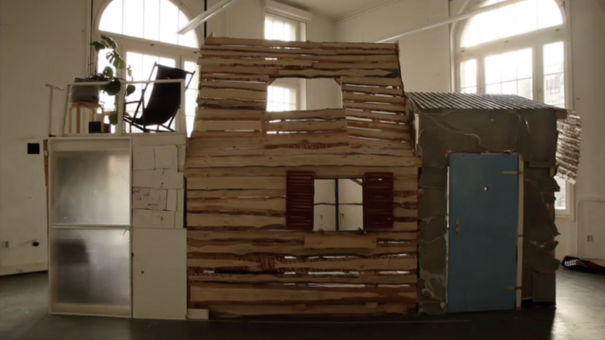
Digital and Experimental Design
The Department of Digital and Experimental Design investigates the conceptual, spatial and constructive influences of digital tools and models of thought on contemporary design practice.
Die inhaltlichen Positionen des internationalen Lehrkörpers sind vielfältig und dokumentieren in Forschung, Lehre und Praxis die Komplexität zeitgenössischen Architekturschaffens -jenseits von Stilen, Denkschulen und Moden. Die Erfahrbarkeit heterogener und kontroverser Blickwinkel auf Themen der Stadt, des öffentlichen Raumes und der Architektur ist erklärtes Ziel der Ausbildung an der Universität der Künste. Die Kollaboration in der Projektarbeit zwischen technischen, theoretischen und künstlerischen Fächern ist dabei verbindlich.
Nach einer zweijährigen Grundlehre steht es den Studierenden des Fachs Architektur frei ihre Entwurfsschwerpunkte selbst zu wählen. Der Fokus der Ausbildung konzentriert sich dabei zunehmend auf die Herausbildung einer eigenständischen gestalterischen Autorenschaft.

The Department of Digital and Experimental Design investigates the conceptual, spatial and constructive influences of digital tools and models of thought on contemporary design practice.

Teaching architecture means understanding oneself and the students as a research team: setting out together on a voyage of discovery in planning, questioning what already exists, teaching responsible, non-hierarchical lateral thinking, trying out and inventing something new.

We are particularly interested in the links between programmatic content and the architectural structures it results in. We believe that new architecture can only be generated through new content.

![[Translate to English:] Foto: Gustav Düsing [Translate to English:]](/fileadmin/_processed_/a/4/csm_FG_Duesing_e29e792fe3.jpg)
Working with concepts of thought/action, place/scale, material/space, representation/perception, structure/construction, function/casing, nature/artificial, here teaching and learning is seen as experimenting, as strategic action within the design process.

The garden is a process of time, and its uniqueness consists of plants, light, shade, wind, rain, and visitors. What defines a garden in the city, and how does it relate to the buildings?

Interested in the multidimensionality of spaces, we aim to frame (or construct or understand) architecture as an aesthetic, political, social and procedural design. Working with questions based in concrete and therefore complex urban situations, we enter these situations and seek to develop within scenarios for their possible futures. The city is a community formed from potentials and ambitions. If architecture can be seen as a product of spatial and urban practice, we want to critically question its conditions and search for new agencies in spatial production.
![[Translate to English:] Foto: Emil Brechenmacher [Translate to English:]](/fileadmin/_processed_/0/e/csm_Bild_8a_Robotic_Setup_Open_Lab_a4182123ee.jpg)
The department follows a transdisciplinary concept in teaching and research. The aim is to convey integral starting points in architectonic design and their realization in research and development assignments.

Five aspects of art and cultural studies define teaching and research in this department: history and theories of culture, fine arts, media and technology, spatial theories, and general aesthetics.

Art in the study programme Architecture does not view itself as merely acting in a supportive function. Instead, we consciously represent artistic design in this context as an autonomous discipline. Artistic production is an essential catalyst to the exploration of personal motivation – and building on this, it helps to boost the individual's positioning in the world.
![[Translate to English:] [Translate to English:]](/fileadmin/_processed_/e/b/csm_25_WiSe_-_Sta__dtebau_394a1b2d5c.jpg)
The basis for any design and theoretical engagement with urban space is the question of its conditions of production and thus of ownership. In order to make their spatialization comprehensible and imaginable otherwise, it is necessary to consider not only the dichotomy of public and private, but also common and/or seperate spaces as a usage-based category.
![[Translate to English:] Foto: Yokohama Apartment, Yokohama Japan. Image: Daniel Burchard [Translate to English:]](/fileadmin/_processed_/e/7/csm_YokohamaApartments_DanielBurchard_a68b7e032e.jpg)

The Department of Building Physics and Building Services Engineering (VPT) teaches building physics, and building services design and technology in both its Bachelor and Master programmes in architecture.